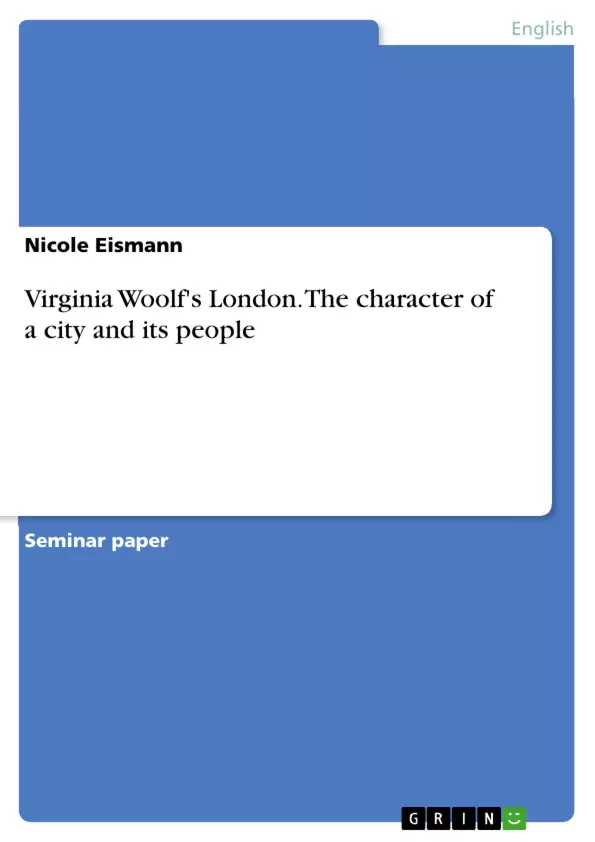“London itself perpetually attracts, stimulates, gives me a play & a story & a poem, without any trouble, save that of moving my legs through the streets.” Virginia Woolf’s home town, London, appears to be one of her greatest inspirations as it is not only setting of several of Woolf's novels but also the main topic in a number of her essays.
At first glance, Virginia Woolf's London is a perfect place of beauty and harmony. Despite mentioning them, the negative aspects of London brought up in her works always seem to be played down with the help of linguistic devices such as the use of irony in case of “the moralist” in “Oxford Street Tide” which can be made out in the following quote: “Even a moralist, who is, one must suppose, since he can spend the afternoon dreaming, a man with a balance in the bank – even a moralist must allow [...]”.
But is this beauty a real overall picture of Great Britain's capital as it is described by Woolf? Or do the mentioned negative aspects still have a bigger influence on the perception of London the reader gets than it appears? Or is the image, Virginia Woolf presents us, in the end even more negative than positive, and from which point of view?
To answer these questions, this paper includes a detailed analysis of two essays which address the city of London as their main issue with a special focus on the people and their perception – “Oxford Street Tide”, one of “The London Scene” essays which describes life in one of London's most famous shopping areas, and “Street Haunting: A London Adventure” in which the narrator takes the reader for a walk around London.
Inhaltsverzeichnis (Table of Contents)
- Introduction
- The people of London
- Representation of London's people in "Oxford Street Tide"
- Representation of London's people in "Street Haunting: A London Adventure"
- Word choice, language style and London's atmosphere
- Atmosphere created in “Oxford Street Tide”
- Atmosphere created in “Street Haunting: A London Adventure”
- Symbolic character of London
- Symbols used in "Oxford Street Tide"
- Symbols used in “Street Haunting: A London Adventure”
- Conclusion
Zielsetzung und Themenschwerpunkte (Objectives and Key Themes)
This paper analyzes two of Virginia Woolf's essays that focus on the city of London, "Oxford Street Tide" and "Street Haunting: A London Adventure," to understand how Woolf portrays the city and its inhabitants. The analysis examines the perspective of different groups of Londoners, the atmosphere created by Woolf's language, and the symbolic character of London in her work.
- The representation of different perspectives of Londoners in Woolf's essays
- The role of word choice in creating the atmosphere of London
- The symbolic character of London in Woolf's writing
- The impact of modernity on London and its inhabitants
- The relationship between individual identity and the anonymity of the city
Zusammenfassung der Kapitel (Chapter Summaries)
The introduction sets the context for the analysis by highlighting Virginia Woolf's deep connection to London, exploring her initial impressions of the city and the complexities of its portrayal in her work. The paper then delves into the diverse perspectives of Londoners, focusing on the contrast between modern thinkers and conservative Victorians in "Oxford Street Tide." This section examines how Woolf uses focalizers to represent these differing viewpoints, exploring the social and economic realities of London in the early 20th century.
The analysis continues by examining the representation of Londoners in "Street Haunting: A London Adventure," exploring the narrator's ambivalent feelings towards the city. The chapter explores the tension between the anonymity of the city and the desire for connection, as well as the impact of urban life on individual identity. The paper then moves on to analyze the atmosphere created by Woolf's language, focusing on the use of word choice and imagery to evoke the specific moods and sensations of London in both essays.
Finally, the analysis delves into the symbolic character of London in Woolf's writing, examining the use of symbols to represent broader themes and ideas. This section explores how specific symbols, like the "moralist" in "Oxford Street Tide," are used to critique societal values and the changing nature of London.
Schlüsselwörter (Keywords)
This paper explores the themes of urban life, modernism, identity, perspective, language, symbolism, and the portrayal of London in the works of Virginia Woolf. It focuses on analyzing Woolf's use of focalizers, word choice, and imagery to create a nuanced and complex understanding of the city and its inhabitants.
- Quote paper
- Nicole Eismann (Author), 2012, Virginia Woolf's London. The character of a city and its people, Munich, GRIN Verlag, https://www.grin.com/document/319149



